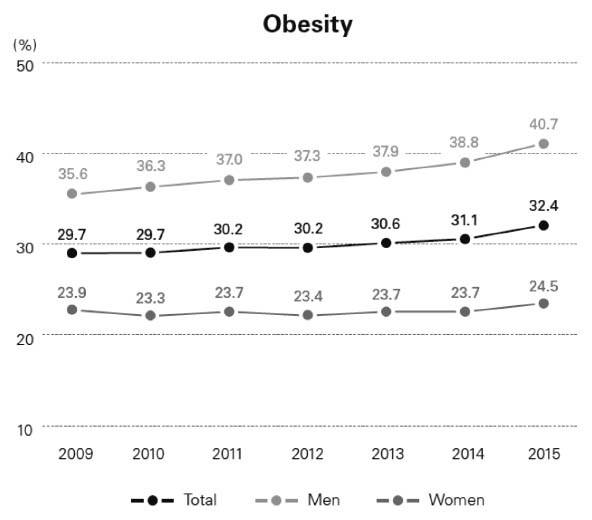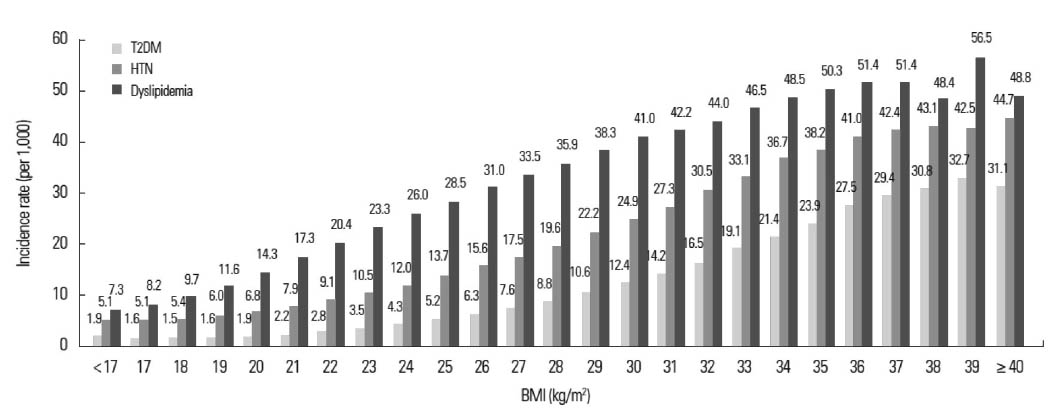J Korean Diabetes.
2019 Jun;20(2):63-66. 10.4093/jkd.2019.20.2.63.
Saxenda® Frenzy: Opinions of an Endocrine and Metabolism Specialist
- Affiliations
-
- 1Division of Endocrine and Metabolism, College of Medicine, The Catholic University of Korea, Seoul, Korea. kimsungrae@catholic.ac.kr
- KMID: 2451833
- DOI: http://doi.org/10.4093/jkd.2019.20.2.63
Abstract
- Globally, the problem of obesity is increasing, and the prevalence of obesity in Korea is also rising rapidly. Obesity is a risk factor for cardiometabolic diseases including type 2 diabetes mellitus, hypertension, cardiovascular disease, and some types of cancer. Therefore, prevention of various metabolic diseases or symptom relief through effective treatment of obesity is a very important problem. According to the obesity guidelines of the Obesity Society of Korea in 2018, obesity medication is recommended for patients with a body mass index (BMI) of 30 kg/m² or more or a BMI of 27 kg/m² or more, and one or more obesity accompanying diseases (type 2 diabetes, hypertension, dyslipidemia). In this case, it is recommended that the basic treatment for obesity (diet, exercise, and behavior therapy) should be performed in parallel with Saxenda® treatment. The glucagon-like peptide 1 analogue, Saxenda®, has been validated as a long-term effective and safe treatment for obesity, and is expected to be a promising drug for the treatment of obesity and the prevention of pre-diabetes in the future. However, in Korea, where non-standard obesity treatments are widely practiced, it is necessary to improve the health of obese patients by being treated with Saxenda® along with diet, exercise and behavior therapy.
MeSH Terms
Figure
Reference
-
1. Ng M, Fleming T, Robinson M, Thomson B, Graetz N, Margono C, Mullany EC, Biryukov S, Abbafati C, Abera SF, Abraham JP, Abu-Rmeileh NM, Achoki T, AlBuhairan FS, Alemu ZA, Alfonso R, Ali MK, Ali R, Guzman NA, Ammar W, Anwari P, Banerjee A, Barquera S, Basu S, Bennett DA, Bhutta Z, Blore J, Cabral N, Nonato IC, Chang JC, Chowdhury R, Courville KJ, Criqui MH, Cundiff DK, Dabhadkar KC, Dandona L, Davis A, Dayama A, Dharmaratne SD, Ding EL, Durrani AM, Esteghamati A, Farzadfar F, Fay DF, Feigin VL, Flaxman A, Forouzanfar MH, Goto A, Green MA, Gupta R, Hafezi-Nejad N, Hankey GJ, Harewood HC, Havmoeller R, Hay S, Hernandez L, Husseini A, Idrisov BT, Ikeda N, Islami F, Jahangir E, Jassal SK, Jee SH, Jeffreys M, Jonas JB, Kabagambe EK, Khalifa SE, Kengne AP, Khader YS, Khang YH, Kim D, Kimokoti RW, Kinge JM, Kokubo Y, Kosen S, Kwan G, Lai T, Leinsalu M, Li Y, Liang X, Liu S, Logroscino G, Lotufo PA, Lu Y, Ma J, Mainoo NK, Mensah GA, Merriman TR, Mokdad AH, Moschandreas J, Naghavi M, Naheed A, Nand D, Narayan KM, Nelson EL, Neuhouser ML, Nisar MI, Ohkubo T, Oti SO, Pedroza A, Prabhakaran D, Roy N, Sampson U, Seo H, Sepanlou SG, Shibuya K, Shiri R, Shiue I, Singh GM, Singh JA, Skirbekk V, Stapelberg NJ, Sturua L, Sykes BL, Tobias M, Tran BX, Trasande L, Toyoshima H, van de, Vasankari TJ, Veerman JL, Velasquez-Melendez G, Vlassov VV, Vollset SE, Vos T, Wang C, Wang X, Weiderpass E, Werdecker A, Wright JL, Yang YC, Yatsuya H, Yoon J, Yoon SJ, Zhao Y, Zhou M, Zhu S, Lopez AD, Murray CJ, Gakidou E. Global, regional, and national prevalence of overweight and obesity in children and adults during 1980-2013: a systematic analysis for the Global Burden of Disease Study 2013. Lancet. 2014; 384:766–781.
Article2. Kang HT, Shim JY, Lee HR, Park BJ, Linton JA, Lee YJ. Trends in prevalence of overweight and obesity in Korean adults, 1998-2009: the Korean National Health and Nutrition Examination Survey. J Epidemiol. 2014; 24:109–116.
Article3. Seo MH, Kim YH, Han K, Jung JH, Park YG, Lee SS, Kwon HS, Lee WY, Yoo SJ. Prevalence of obesity and incidence of obesity-related comorbidities in Koreans based on National Health Insurance Service Health Checkup Data 2006-2015. J Obes Metab Syndr. 2018; 27:46–52.4. Korean Society for the Study of Obesity. Guideline for the management of obesity 2018. Seoul: Korean Society for the Study of Obesity;2018.



